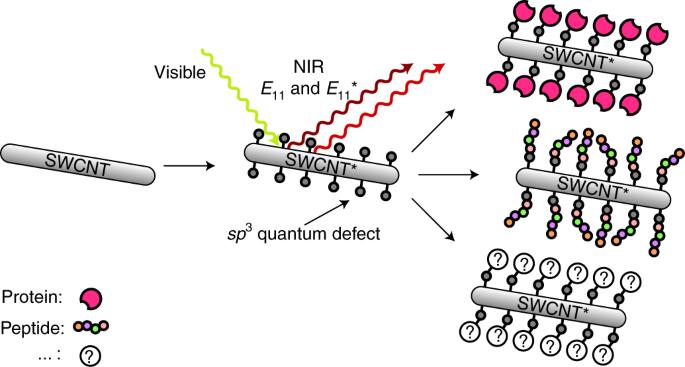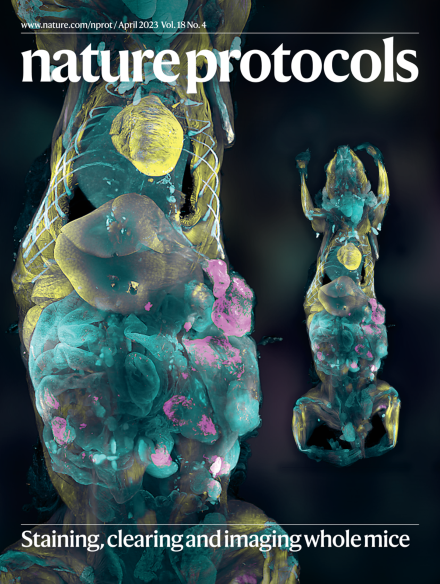Quantum defects as versatile anchors for carbon nanotube functionalization
IF 16
1区 生物学
Q1 BIOCHEMICAL RESEARCH METHODS
引用次数: 11
Abstract
Single-wall carbon nanotubes (SWCNTs) are used in diverse applications that require chemical tailoring of the SWCNT surface, including optical sensing, imaging, targeted drug delivery and single-photon generation. SWCNTs have been noncovalently modified with (bio)polymers to preserve their intrinsic near-infrared fluorescence. However, demanding applications (e.g., requiring stability in biological fluids) would benefit from a stable covalent linkage between the SWCNT and the functional unit (e.g., antibody, fluorophore, drug). Here we present how to use diazonium salt chemistry to introduce sp3 quantum defects in the SWCNT carbon lattice to serve as handles for conjugation while preserving near-infrared fluorescence. In this protocol, we describe the straightforward, stable (covalent), highly versatile and scalable functionalization of SWCNTs with biomolecules such as peptides and proteins to yield near-infrared fluorescent SWCNT bioconjugates. We provide a step-by-step procedure covering SWCNT dispersion, quantum defect incorporation, bioconjugation, in situ peptide synthesis on SWCNTs, and characterization, which can be completed in 5–7 d. Carbon nanotubes are modified by introducing quantum defects with functional handles into the carbon lattice. The functionalization preserves their near-infrared fluorescence and enables covalent bioconjugation and peptide synthesis.

作为碳纳米管功能化多功能锚的量子缺陷
单壁碳纳米管(SWCNT)可用于各种需要对其表面进行化学定制的应用,包括光学传感、成像、靶向药物输送和单光子生成。人们用(生物)聚合物对 SWCNT 进行非共价修饰,以保持其固有的近红外荧光。然而,要求苛刻的应用(如要求在生物液体中保持稳定)将受益于 SWCNT 与功能单元(如抗体、荧光团、药物)之间稳定的共价连接。在此,我们将介绍如何利用重氮盐化学在 SWCNT 碳晶格中引入 sp3 量子缺陷,以作为共轭的手柄,同时保留近红外荧光。在本方案中,我们介绍了如何将 SWCNT 与生物大分子(如肽和蛋白质)进行直接、稳定(共价)、多用途和可扩展的功能化,从而获得近红外荧光 SWCNT 生物共轭物。我们提供了一个包括 SWCNT 分散、量子缺陷掺入、生物共轭、在 SWCNT 上原位合成多肽和表征的分步程序,该程序可在 5-7 d 内完成。这种功能化保留了碳纳米管的近红外荧光,并实现了共价生物共轭和多肽合成。
本文章由计算机程序翻译,如有差异,请以英文原文为准。
求助全文
约1分钟内获得全文
求助全文
来源期刊

Nature Protocols
生物-生化研究方法
CiteScore
29.10
自引率
0.70%
发文量
128
审稿时长
4 months
期刊介绍:
Nature Protocols focuses on publishing protocols used to address significant biological and biomedical science research questions, including methods grounded in physics and chemistry with practical applications to biological problems. The journal caters to a primary audience of research scientists and, as such, exclusively publishes protocols with research applications. Protocols primarily aimed at influencing patient management and treatment decisions are not featured.
The specific techniques covered encompass a wide range, including but not limited to: Biochemistry, Cell biology, Cell culture, Chemical modification, Computational biology, Developmental biology, Epigenomics, Genetic analysis, Genetic modification, Genomics, Imaging, Immunology, Isolation, purification, and separation, Lipidomics, Metabolomics, Microbiology, Model organisms, Nanotechnology, Neuroscience, Nucleic-acid-based molecular biology, Pharmacology, Plant biology, Protein analysis, Proteomics, Spectroscopy, Structural biology, Synthetic chemistry, Tissue culture, Toxicology, and Virology.
 求助内容:
求助内容: 应助结果提醒方式:
应助结果提醒方式:


